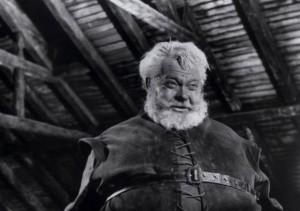
For decades, Orson Welles’ masterpiece “Chimes at Midnight” has been unavailable to the general public. After a 20 year effort, Janus Films has re-released the film in a carefully restored edition that became available to audiences on Feb. 12, 2016.
Being auteur that he was, Welles wrote, directed and starred in the film, playing the complex character of Sir John Falstaff. The film was met with critical acclaim upon its release in 1967, and Welles himself considered it one of his favorite works.
Drawing from five Shakespeare plays, including three parts of “Henry IV,” “Richard III” and “The Merry Wives of Windsor,” the screenplay is a wonderful tribute to the Bard’s mastery of language and characterization. This is most evident through the character of Falstaff, a complicated man of great wit and minimal refinement. Based primarily on physical resemblance, it would seem that Welles was born to play the classic Shakespearean character Falstaff. With a round protruding belly, ruddy cheeks, an air of mischief and good humor, Welles fits the character perfectly.
Falstaff befriends Prince Hal (Keith Baxter), the heir to the throne of England, and shows him a life of gluttony, sloth, prostitution and gambling, yet manages to teach him more than simple mischief along the way.
Prince Hal’s father, King Henry (John Gielgud), is implicit in the murder of his predecessor, King Richard II. Falstaff serves as a friend and role model to the prince, and from this relationship comes the film’s overarching theme: the need to acknowledge subtlety and nuance in everyone and everything, and the difficulty of characterizing one as simply good or evil.
Perhaps one of the most striking aspects of the film is the use of light and shade, which is even more noticeable in the restored version of the film. Light beams through barred windows upon the corrupt new king, signaling his implicitness in the crime. Conversely, Welles makes use of shadow and shade in scenes with closed forms, such as a beautifully shot scene of Falstaff and Prince Hal’s interaction on a narrow staircase, where darkness pervades and small patches of light peek through. The carefully executed lighting seems to highlight implicit perceptions of the characters, allowing the audience to interpret on their own.
In addition to lighting, the camera angles – particularly the use of close-ups – are disorienting at times, but highly attention grabbing. When depicting characters of the nobility or in the court, the distant, low-angle camerawork from the ground gives the characters a larger than life screen presence. Yet Welles also utilizes close-up shots, particularly with Falstaff and the prince, to invite the audience to take a closer look at their characters. The strategy is quite effective in giving the king and the other nobility a sense of pompous snobbery, while Falstaff and Prince Hal are humanized and more relatable at such close proximity.
The most impressive feat of Janus Films’ restoration of “Chimes at Midnight” is the sound quality. The film features vibrant music, with great use of trumpets and drums, that would have otherwise sounded fuzzy and shrill in the original version. The loud yells of rabble-rousers in bars and parades in the street are perfectly harmonized with modern technology, making the re-release worth the 20-year wait.
“Chimes at Midnight” can stand alone as one of Welles’ crowning achievements. From the witty screenplay to his dominating performance to the chiaroscuro style, the restored film lives up to and only expands Welles’ legacy.














